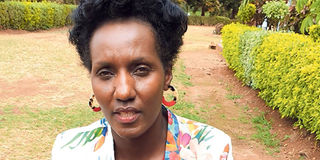Look out for better fish species in coming months

Dr Domitila Muendo, a research assistant at the Kenya Marine and Fisheries Research Institute in Sagana. She says farmers should soon expect new fish breeds that are fast-maturing. PHOTO | RACHEL KIBUI | NMG
What you need to know:
- The main component in fish farming is water.
- Erratic rains cause ponds to flood and sweep away fish.
- Farmers should expect new fish breeds that are fast-maturing.
- The country, therefore, has to rely on imported fish.
Climate change has hit many agricultural sub-sectors, with the aquaculture industry being among those feeling the pinch. Dr Domitila Muendo, a research assistant at the Kenya Marine and Fisheries Research Institute in Sagana, spoke to Rachel Kibui on how farmers can still raise their production
How has climate change, characterised by scarce rains, erratic temperatures and rise in diseases affected fish production?
The main component in fish farming is water. This means that during prolonged dry seasons, rivers dry up and water reduces in fish ponds.
This causes fish to be stressed. Besides, farmers need to change water in ponds, and when this is not possible, infections are common. On the other hand, erratic rains cause ponds to flood and sweep away fish.
Recent reports have indicated that our rivers and lakes are grossly polluted with effluent from households and industries. Should the fish consumer be worried?
Certainly yes, but relevant authorities should put in place strict measures to mitigate pollution and its effects so that fish does not contain contaminants like heavy metal residues.
As for farmed fish, farmers should always employ good agricultural practices to ensure food safety standards are observed.
The European Union, in collaboration with the government, has offered 6.5 million Euros (Sh747.5m) for the development of climate-smart technologies and address constraints that hinder farmers from optimum production. Of this amount, Sh8.05 million will be channelled to aquaculture. What should fish farmers look forward to?
Farmers should expect new fish breeds that are fast-maturing. We are hoping to upgrade tilapia to an F8 breed.
Besides, we anticipate to multiply, and hopefully introduce to commercial farming some indigenous fish breeds like Tilapia Jipe, Tilapia Baringoesis and Labeo Victorianas, which are facing extinction. Farmers should also expect better, hopefully cheaper fish feeds in which black soldier fly will replace omena as a source of protein.
Farmers shy away from aquaculture due to high cost of feeds. Can this situation be corrected?
True. Currently, feeds account for about 70 per cent of fish farmers’ expenses. Fish feed is not only expensive, but also scarce, a thing that has forced farmers to feed their fish on omena, which is meant for human consumption.
We will embark on mass production of the black soldier fly, which is a larva that utilises farm waste, and offers the best protein ingredient for production of livestock feeds.
This will reduce competition for omena with human beings.
Kenya has been relying on imported fish, especially from China. Will the EU project change the tide?
Fish accounts for 20 per cent of all animal protein consumed locally. While the demand stands at about 400,000 tonnes a year, local production stands at about 150,000 tonnes.
The country, therefore, has to rely on imported fish. This project will focus on promoting aquaculture as a viable agribusiness to increase production.
This project will also focus on beans, small ruminants and avocados, among others.
What can be done to make the youth embrace aquaculture?
With the demand for fish soaring, aquaculture can earn the youth good money.
The youth can work in groups to lower start-up capital contributions, boost production and later bargain for good market prices.





